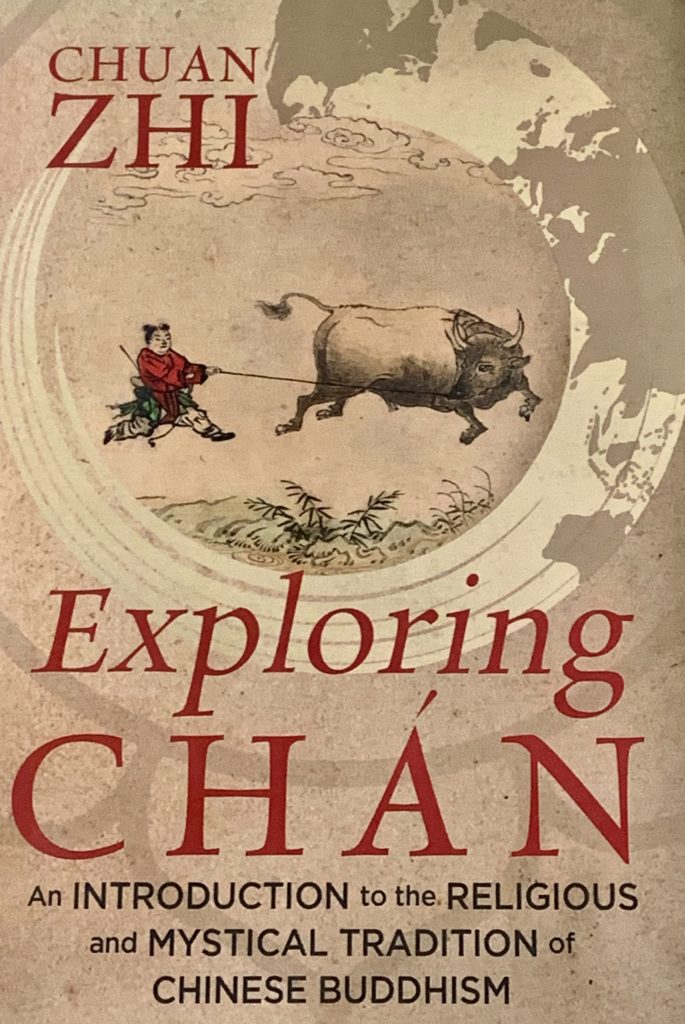I’ve just completed reading Chuan Zhi’s Exploring Chan: An Introduction to the Religious and Mystical Tradition of Chinese Buddhism (Songlark, 2019). Chuan Zhi’s biography states he is an American covert-Buddhist ordained as a monk at China’s Hong Fa Temple in 1998, practices in the Linji Chán tradition, and was the former abbot of the Zen Buddhist Order of Hsu Yun (ZBOHY). ZBOHY is an online resource for the study and practice of Chán Buddhism designed for outreach to Western Buddhists. I’m not familiar with that Order, and will only note that there are (or at least were) two competing websites claiming to represent that Order. Chuan Zhi’s Exploring Chán (www.eyeofchan.org) website states his own Order was dissolved in 2018.
The book is well written, and Chuan Zhi is deeply conversant with Chán practice, Buddhist history and philosophy, and current scholarship concerning the Chán tradition, as well as with Western psychology, philosophy, literature, and music. All of this makes him an interesting bedstand companion. The book’s many virtues made it a pleasure to read, even though I disagree with the author on a number of points I will get to later.
The main theme of the book is that one can separate the outer religious trappings of Chán/Zen from its inner core as a mystical journey of discovery. Religious institutions come to serve a wide variety of purposes that are separable from— and at times antithetical to—their core teachings and mission. They can compete for Imperial support or provide comfortable livelihoods for the clergy in lean times. They can provide a sense of belonging or moral rectitude for their followers, while enforcing conformity of thought. They can organize around charismatic figures who take material and sexual advantage of their adherents. They can provide aid and support to nation states in their conduct of immoral wars. Chuan Zhi is aware of all the pitfalls that Chán and Zen qua institutions can fall prey to. Their shortcomings, however, do not invalidate their core truths, which Chuan Zhi reads as primarily mystical ones.
Chuan Zhi has kept up with the scholarly work of John McRae, Alan Cole, Robert Sharf, Brian Victoria, Griffith Foulk and others who have helped to demythologize Chán/Zen’s own self-narrative. In his historical chapters on Chán and Zen, Chuan Zhi admirably describes the many problems involved in the Chán/Zen depictions of its ancestors and its chain of transmission. He also does a good job in the later part of his book of enumerating some of the potential negative side-effects of meditation, including the retriggering of trauma, the initiation of dissociative states, and the descent into psychosis, and offering some advice on how to handle these problems. While his advice seems helpful from a common sense perspective, we really know very little about how to treat meditative casualties, and he omits the possibility that there are times when professional mental health interventions are called for.
I disagree with Chuan Zhi on a number of points. My most significant disagreement is with his use of Carl Jung’s theories about individuation and the emergence of the archetype of the Self to map the Chán/Zen journey. I’ve no doubt that Chuan Zhi’s own personal Zen journey of discovery has corresponded in many, if not in all ways, with the journey to Selfhood Jung describes, and that this has been a liberating journey for him. I’ve noted, in my own writing, some of the formal similarities between certain aspects of Jung’s system and the Buddhist path. Both involve a discovery that the person we identify as ”our self” is a case of mistaken identity, and that we are actually larger than we first imagined. Both make use of the metaphor of a false ”small self” and a larger true self. But these similarities also mask genuine differences. The larger Jungian Self involves the integration of previously unconscious archetypal energies. It is primarily an inward journey. The larger MahÄyÄna Buddhist self involves the effacement of the self/other boundary, and is essentially a journey in which terms such as ”inner” and ”outer” lose their significance. Jung’s Self includes the shadow and the anima/animus, while Dōgen’s non-self includes mountains and rivers, grasses, and trees, and ”fences, walls, tiles and pebbles.”
This tendency to interpret Buddhism in terms of ”something else” is common when cultures borrow and adopt teachings derived from other cultures. The Chinese did this when they interpreted Buddhism in Daoist terms. Yes, the Buddhist path has resonances with Jungian psychology, but it also has resonances with Stoicism, Aristotelianism, Spinoza, Vedanta, Romanticism, Whitehead’s philosophy of organism, and many other things. The fact that the Jungian schema maps onto Chuan Zhi’s personal journey doesn’t mean it best describes everyone’s journey or even most people’s journeys on the Buddhist path. It certainly doesn’t map onto my own experience.
In Chuan Zhi’s catalogue of Chan and Zen practices, he sees a progression along a four-stage process from mindfulness, to concentration, to contemplation, to meditation. He reserves the term ”meditation” for self-transcendent experiences of various kinds, including Jungian archetypal encounters, the divine union of the masculine and the feminine, and experiences of ”the Void.” In this typology, he categorizes shikantaza as a mindfulness practice of only limited value, at best a preliminary to concentration, contemplation, and meditation practices. He doesn’t believe one can derive the benefits he attributes to ”meditation” through shikantaza. To be fair, he’s hardly alone in his opinion. ”Silent illumination” has been in dispute ever since Hongzhi Zhengjue (1091-1157) introduced it. Chuan Zhi certainly has a right to his opinion, but my own belief is that different methods are probably better suited for different people. I’ve personally found shikantaza more beneficial, so far, than my concentration or koan practices. Why not leave that possibility open?
Chuan Zhi is rightfully appalled by Japanese Zen establishment’s readiness to be enlisted in a variety of nationalistic projects, including the Japanese atrocities committed against China and Korea. He sees Japanese Zen as tainted by the traditional Japanese cultural veneration of the Emperor and nation state (although, to give credit where credit is due, he also appreciates the contribution of Japanese esthetics to Zen). There are times, however, where I think he misreads the Japanese character. In his Epilogue, Chuan Zhi claims Chinese ancestor worship was ”too foreign” to Japanese culture for the Japanese to ”adopt” it, and that they substituted it with veneration of the emperor. This will probably come as a surprise to most Japanese.
Despite my reservations about some of Chuan Zhi’s opinions, I think the book has much to offer the reader. I see it as a valiant contribution to the ongoing project of adapting Buddhist practice so that it offers a better fit with the way we modern Westerner’s apprehend and think about the world. One aspect of Western modernism is the corrosive effect modern historical scholarship has on religious hagiography. Can one see though falsehoods that are inevitably woven into the fabric of our institutions and yet still discover the value within them? This is a distinctly modern task, and books like Chuan Zhi’s are a contribution to that effort.

